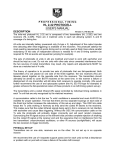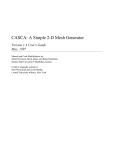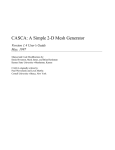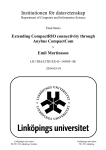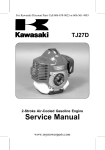Download User Manual
Transcript
User Manual SAVER Chair S-242T stoličky January 2010 SAVER Chair S-242T Disclaimer This manual contains general instructions for the use, operation and care of this chair. The instructions are not all-inclusive. Safe and proper use of this chair is solely at the discretion of the user. Safety information is included as a service to the user. All other safety measures taken by the user should be within and under consideration of applicable regulations. It is recommended that training on the proper use of this chair be provided before using this chair in an actual situation. Retain this manual for future reference. Include it with the chair in the event of transfer to new users. Additional free copies are available upon request from SAVER Manufacturing. Maximum Load Capacity - 180 Kg [2] SAVER Chair S-242T Wall mounting bracket Wall Bracket • Using the Bracket plate as a template, mark the surface where the holes are to be drilled. Taking in to account height of chair. • Drill the holes, using the appropriate size drill bit to suit your fittings. • Once the wall plugs have been fitted into the drilled holes fit the bracket plate (using the appropriate length screws) then tighten screws appropriately. • Place the folded chair, with track strapped to chair and track on the floor against the wall. • Feed strap from wall bracket around chair foot rest and tighten to secure chair. • Cover the chair with dust cover provided by fixing to Velcro on the wall bracket. • ENSURE STAFF ARE TRAINED IN THE USE OF THE CHAIR. [3] SAVER Chair S-242T QUICK SET-UP GUIDE – TO UNFOLD THE CHAIR For the purpose of this guide, the S-242T Chair will be referred to as the Chair and the person being transported on the Chair will be referred to as the patient. The Chair will normally be left in the folded condition and the first task will be to unfold and make the Chair safe for transporting a person. 1. Unbuckle the chest strap securing the chair and fold the chair out into the seated position. [4] SAVER Chair S-242T 2. Just below the seat there is a bar that automatically locks the chair in to the seated position, ensure this is engaged and secure before seating the patient in the chair. DO NOT PULL DOWN THE FOOT REST UNTIL PATIENT IS SEATED. 3. The chair is fitted with an adjustable height handle. For the handle adjustment into other requested position it is necessary to pull and rotate on 90° degrees of the groove pin at the right side handle in the order to lock off at the right side handle. Thereafter it is necessary to lock off left goove pin at the left side by pulling and holding in unmesh position. You have to adjuste the handle by movement down or movement up at pin pulling till reaching of requested position. After groove pin locking off at the left side, it is necessary to lock the pin at the right side handle. Having to be sure about correct pin fitting (locking) resulting the correct locking handle position. [5] SAVER Chair S-242T [6] SAVER Chair S-242T 4. Once the patient has been seated comfortably in the chair pull down the foot rest and place their feet on to it. Fasten all restraining straps to secure the patient. QUICK SET-UP GUIDE – UNFOLD & FOLD TRACK The track aids descent on stairs, do not unfold the track if the chair is not needed to descend stairs. 5. To fold the track into the back of the chair push the lever downwards as shown, until track is flush with the back of the chair and locks in to position. [7] SAVER Chair S-242T 6. To unfold the track from the rear of chair pull the bar fitted to the track until the track locks in to position. QUICK SET-UP GUIDE – FOLD CHAIR 7. Before folding the chair for storage ensure castors are locked facing forward, the foot rest is up and all handles are not extended [8] SAVER Chair S-242T 8. Squeeze the bar shown picture, and collapse chair in to folded position). [9] SAVER Chair S-242T QUICK SET-UP GUIDE – TELESCOPIC CARRY HANDLES 9. The chair is fitted with telescopic carrying handles to aid carrying the chair down stairs. To change position of the handles press button and pull/push handles to extend or shorten. FOOT SUPPORT 10. The foot support is part of this chair. For unfolding is necessary to pull the chair frame down and for folding is necessary to pull the chair frame up. [10] SAVER Chair S-242T 1. Intended Use For the purpose of this manual, the S-242T Chair will be referred to as the Chair and the person being transported on the Chair will be referred to as the patient. The Chair is a handling device designed to transport a patient, in a seated position, on stairs and level ground. The Chair will glide smoothly down a wide range of stair types and can quickly return to a four wheel chair at the end of a run of stairs. When on two or four wheels it can rotate within its own length making it ideal for half landings and similar restricted areas. Where conditions require the chair may also be carried using the anti-slip handle grip areas. 1.1 Safety Precautions To ensure safety and satisfaction with your new Chair, all users should read these instructions and the individual portions of recognised emergency care manuals that relate to the application and use of Carrying Chairs. It is recommended that a minimum of two trained operators control a loaded Chair on stairs, they should assess whether additional assistance is required. 1.1.2 Operator Skills Minimum recommended skills are as follows: The strength, balance, co-ordination and common sense to safely operate the Chair. The ability to select the proper equipment and procedures for the circumstances. Operators should have been trained in the operation of the Chair. The ability to understand and follow the procedures described in this manual. Operators should have a working knowledge of emergency patient-handling procedures. 1.1.3 Operator Training Minimum recommended training is as follows: A training plan approved by an EMS training officer (or equivalent). Read and understand the instructions in this manual. Practice using the fully-equipped Chair with weight and under simulated conditions. Trainees should be tested to verify their understanding of Chair operation. Keep training records. Annual refresher training for all Chair operators is recommended. [11] SAVER Chair S-242T WARNINGS Never exceed the maximum load capacity of 180 Kg. Only qualified personnel trained in the use of the Chair should use it. For safety purposes, it is essential that patients should always be secured with restraints. Never leave a loaded Chair unattended. An unloaded Chair may tip backwards. If located on an incline, wherever possible face. the Chair down an incline with the castor locks engaged. Avoid rapid Chair repositioning – this may cause injury to the patient. Support the Chair while adjusting handles. Establish regular inspection procedures and responsibilities to ensure proper maintenance as described. In cases of cervical, spinal or some fracture injuries, use of the Chair for patient transfer is not recommended. Never leave the Chair unsupported with a person on-board as the Chair is designed to tilt back easily. Improper maintenance can cause injury and unpredictable operation. Maintain the Chair only as described in this manual. Improper parts and service can cause injury and damage. Use only SAVER-approved parts and service. Bleach, phenols and iodine can cause damage. Do not apply products containing these chemicals to the Chair. Improper lubricants can cause damage. Use light oil to lubricate the Chair. Blood borne Disease Notice -To reduce the risk of exposure to blood borne diseases (such as HIV-1 and hepatitis), when using the Chair, follow the maintenance instructions in this manual. [12] SAVER Chair S-242T ESSENTIAL REQUIREMENT Every three months lubricate the hinge pins with light oil paying particular attention to the cross section bolts. NEVER LUBRICATE OR ALLOW LUBRICANTS TO COME INTO CONTACT WITH THE TRACK SYSTEM [13] SAVER Chair S-242T 2. S-242 T Chair Operation –Refer to pages 4 - 10 for the Quick Set-up Guide 2.1 Folding and Unfolding the Chair The Chair folds for shipping and stowage. To Unfold 1. Release the chest strap from the Chair and allow the chair to fold down into the seated position. 2. Completely unfold the Chair by firmly pushing up the back until an audible click is heard, this is the locking bar engaging into the locking catches, visually confirm this. To Fold When folding the chair ensure the following procedure is carried out: 1. Fully lower the Upper Handle (see below) 2. Check that the carrying handles at the front of the chair are not extended. 3. Ensure foot rest is folded up. 4. Ensure the track is folded flush with the back of chair. 5. Check the front castors are locked and facing forward to prevent them obstructing the chair frame when folding. 6. To release the chair for folding pull the locking bar at front of the chair and fold the Chair forwards until it is flat. 7. Stand the chair upright on the back wheels. 8. The castors can now be unlocked, turned sideways and locked again so that they lay flush with the chair for stowage. 9. The Chair chest strap can be used to secure the Chair in the closed position. [14] SAVER Chair S-242T 2.2 Height Positional Upper Handle 1. The upper handle can be locked into three different positions to assist operations on stairs and also to allow for height variations of operator and patient. 2. The chair is fitted with an adjustable height handle. For the handle adjustment into other requested position it is necessary to pull and rotate on 90° degrees of the groove pin at the right side handle in the order to lock off at the right side handle. Thereafter it is necessary to lock off left goove pin at the left side by pulling and holding in unmesh position. You have to adjuste the handle by movement down or movement up at pin pulling till reaching of requested position. After groove pin locking off at the left side, it is necessary to lock the pin at the right side handle. Having to be sure about correct pin fitting (locking) resulting the correct locking handle position. 2.3 Extending Carrying Handles • The telescopic carrying handles are located at the front of the chair just above the castor wheels and are to be used in conjunction with the Track Wheels. When using the Track Wheels extend the handles to suit the height of the operator. • The handles are easily extended or shortened by pressing down on the buttons located on the handles with the thumb and pulling or pushing the handles to extend or shorten. Ensure the handles are locked before attempting to lift or carry the chair. 2.4 Patient Restraints Use the lap and foot restraints to secure patient into the Chair. Assess patient condition to determine optimum strapping procedure. o Chest Restraint - The chest restraint is also used to secure the chair closed for stowage. Fasten the chest restraint using plastic male/female buckle system. Pull the loose end free end of the webbing strap to tighten the restraint. o Foot Restraint -Once the patient’s feet are comfortably placed on the integral footrest, the loose foot restraint can be fastened to secure the feet. Fasten foot strap using plastic male/female buckle system. Pull the loose free end of the [15] SAVER Chair S-242T webbing strap to tighten the restraint. Remember that the foot restraint also protects the operator when moving the Chair on stairs. o Releasing Restraints -To release foot and lap restraints, squeeze the two sides of the tang on the buckle inward at the same time and pull the buckle apart. 2.5 S-242 T Chair Wheels The Chair is fitted with two large wheels to the rear and twin wheeled braked castors below the foot rest. • The Chair may be wheeled using all four wheels where the front swivel castors provide excellent manoeuvrability, alternatively, should conditions require, the chair may be tilted back and run on the two larger wheels. ALWAYS inform the patient of your intensions. • To apply the brakes on the swivel castors, turn the castors facing outwards to allow access to the brake pedal, press the brake pedal down. To release the brake push the lever on the top of the castor with your foot. 2.6 S-242T Chair In addition to the wheels the Chair is fitted with a track system to allow the operators to glide the chair down stairs instead of lifting and carrying. Guidelines for using the track system – • Using the Chair on stairs requires a minimum of two trained operators. SAVER Manufacturing recommends using a third person as a “spotter” (see, using the Chair on Stairs). • Verify that the track is fully opened and locked into place before using it. • Verify that the telescopic handles are locked before lifting. • Never lubricate track belts. Lubricated track belts can perform unpredictably, resulting in injury to the patient and/or operators. • Moisture, water, snow, ice or debris on or between the track and belts can cause irregular track-belt performance that results in sudden changes in the weight operators must support. Make sure the track and track belts are clean and dry before using the Chair on stairs. [16] SAVER Chair S-242T • Always clear stairs of debris etc., which could interfere with the operation of the Chair or impede the operators. Opening the Track – 1. Grasp the top of the chair with one hand and with the other grasp the track release bar (red labelled) located near the top of the tracks and firmly pull it back until the track locks into the fully extended position. 2. Verify that the lock is engaged by trying to push the track closed. If the lock is fully engaged the track will not move. Closing the Track – 1. With one hand, grasp the track release bar (red labelled) located near the top of the tracks and with the other hand push down on the track closing handle located on the right side of the tracks. Pushing the track closed with the track release bar will assist this action. 2.7 Checking the S-242T Chair The following checks are required each day before the use of the Chair: • Overall cleanliness of the Chair. • Check that there are no bent or damaged parts, missing fasteners, etc. • Check that the wheels rotate freely with no excess movement or damage. • Check that the Chair unfolds and locks securely in the seating position for normal use. • Check that the track system opens and closes correctly, examine the tracks for damage. • Check the upholstery for cracks, splits or any loose fabric or stitching, etc. • Check that the upholstery is correctly secured to the frame. If in any doubt then contact a SAVER Fieldcare Service Engineer. Regular cleaning helps reduce the risk of transmitting disease and enables the equipment to function at its optimum. [17] SAVER Chair S-242T 3. Operating Procedure 3.1 General Information IMPORTANT : Always inform the patient before a manoeuvre. IMPORTANT : Chair operation requires a minimum of: • Two trained operators when the Chair is being used to transport a patient on stairs. • One operator only, can safely use the Chair on flat surfaces including single steps, thresholds etc. but this must be at the discretion of the operator who must assess all likely conditions. • One operator can safely load/unload a patient using the Chair from a vehicle fitted with a ramp, automatic tail-lift or other approved mechanical lifting mechanism. • Circumstance such as access, weather conditions or patient weight may require additional help when operating on stairs; this must be assessed at the time however the following is a suggested configuration. [18] SAVER Chair S-242T • Placement techniques, heavy patients, rough terrain or unusual circumstances may require more additional help; this must be assessed at the time however the following is a suggested configuration. • Keep the load limit of the Chair in mind when working with a heavy patient. If it suspected that the load limit has been exceeded then a full inspection of the Chair should be conducted, preferably by Saver Fieldcare. • Operators must take extra precautions when operating the Chair on uneven ground. • Extra precautions should be taken to prevent the Chair from slipping in adverse, wet or icy weather conditions. • Stay with the patient at all times and always use the patient restraints provided. • Always follow good lifting procedures as specified in current manual handling regulations and your appropriate training manual. • Follow standard emergency patient-handling procedures when operating the Chair. • Medical advice is beyond the parameters of the manual. It is the user’s responsibility to ensure safe practices for both themselves and the patient. WARNING Improper use can cause injury! Use the Chair only for the purpose described in this manual. 3.2 Moving the Chair • Place the patient on the Chair using local protocols for patient handling. Ensure that the patient is seated with their back fully against the back panel and their head securely positioned within the head pad (see page 6 for fitting of Head Pad) before using the lap restraint. • Chest and foot restraints must be applied before moving the Chair. [19] SAVER Chair S-242T WARNING Before positioning the patient on the Chair, always ensure the Chair is fully unfolded and that the safety rings are up and over each hinge bracket. • When moving patients always inform them of what you are going to do. WARNING Never leave a patient unattended in the Chair and always use restraints. WARNING Avoid rapid Chair repositioning as this may result in patient injury. Support the Chair while adjusting handles.. 3.3 Using the Chair on Level Ground • Before rolling the Chair on level ground, the head end operator adjusts the upper handle to the desired position for comfortable use. • Inform the patient so that they are aware about what is happening. • Two castor wheels are affixed to the foot end frame. These assist with movement on level ground and mean that the Chair can be used without tilting backwards. • The operator at the foot end of the Chair assists as required with obstacles like door frames or uneven surfaces. The lower handle can be used to overcome larger obstacles. [20] SAVER Chair S-242T 3.4 Gliding the Chair Down Stairs • It is strongly recommended that the following procedures be practiced with a chair loaded with dummy weights such as bagged builders sand or gravel. • Using the Chair on stairs requires a minimum of two operators. Use additional help as needed to control the Chair (see page 12). • It is recommended that the two operators face each other when transporting a patient down stairs. If available a third person should assist by acting as a guide for the foot-end operator. • Ensure the route down the stairs is clear of obstructions that could affect the safety of the operators or the function of the tracks (see page 10). 1. Head-end operator – fully extend the upper handle and ensure it is locked. (see page 9). 2. Head-end operator – lower the track and ensure it is locked (see page 11) 3. Foot-end operator – take up position on the stairs facing the chair gripping the lower foot-end handle. 4. Both operators – working together, guide the Chair over the edge or the top step, allowing the track belts to engage the step. 5. Both operators – move the Chair slowly downwards until the tracks are resting on the top two or three steps. This establishes the glide angle. Ensure both operators are comfortable before proceeding. 6. To maintain the glide angle – • Foot-end operator – applies slight downward pressure on the extended upper handle. • Head-end operator – applies slight upward lift to the foot-end lift handles. 7. Both operators – when chair reaches the bottom of the steps and rear wheels are on the floor, the foot end operator releases the foot-end handle, the head-end operator tips the Chair forward until all four wheels are on the floor. 8. If this is the end of the stairs then the Head-end operator can fold the track and lower the upper handle to a comfortable height. [21] SAVER Chair S-242T TO PAUSE DURING DESCENT To pause during the descent, tilt the Chair forward just enough to allow the rear wheels to rest on the step while both operators hold the Chair in place. To continue down the stairs, tilt back the Chair and regain the glide angle (see step 5 above) • Up Stairs Once the patient is seated on the Chair and restrained, adjust the upper handle into a position that is comfortable for your height. (See Section 2.2 on Upper Handle). The upper handle position can be changed to provide a better hand grip. Always inform the patient about what is happening. Once the head end and foot end operators are in their correct positions grasping the upper and lower handles, the head end operator leans the Chair backwards until the patient’s weight is on the transport wheels. At this point, the lower handle is more easily accessible to the foot end operator. The Chair can then be rolled towards the foot of the stairs. Position both track assemblies squarely against the facing edge of the step. The operators can then move the Chair up the stairs by pushing (foot end operator) and pulling (head end operator). The head end operator is responsible for guiding the Chair up the stairs whilst the foot end operator assists as required. If there is a need to manoeuvre the Chair on stairs the head end operator may need to adjust the upper handle to a higher or lower position. When pushing and pulling the Chair upstairs, the operators can pause, providing they maintain a firm grip on the upper and lower handles. [22] SAVER Chair S-242T 4. Care of the S-242T Chair 4.1 Maintenance The S-242T Chair requires regular maintenance. Set up and follow your own maintenance schedule but use the following as a minimum. More frequent maintenance will be required in situations of heavy use. If any damage is discovered, take the Chair out of service until repair or replacement can be made. When using any product for maintenance, follow the manufacturers’ guidelines and read the manufacturers’ material safety data sheet. WARNING Improper maintenance can cause injury. Maintain the Chair only for the purpose described in this manual. 4.2 Disinfection Disinfect all surfaces of the Chair including the head pad and patient restraints. Follow disinfectant manufacturers’ directions for use. Spray or wipe disinfectant onto the patient restraints. Do not immerse in disinfectant. [23] SAVER Chair S-242T 4.3 Cleaning Clean the Chair and its components with a clean cloth or soft brush and warm soapy water. Rinse with warm water and air dry. Do not clean with products containing bleach or phenol. A stiff bristled brush can be used if necessary. [24] SAVER Chair S-242T 5. Warranty and Service Standard terms and conditions apply to all sales. A copy is available upon request. These contain full details of warrant terms and do not limit the statutory rights of the customer. For service, maintenance and any questions regarding this, or any other Saver product, please contact: SAVER Manufacturing Bošáca 893 913 07 Slovakia Telephone: +421 (0) 32 77 81 071 Fax: +421 (0) 32 77 81 067 or your local distributor. [25] SAVER Chair S-242T 6. Technical Data All dimensions are approximate Load capacity is total weight distributed in accordance with basic human anatomy proportions. Attendants must consider the weight of the patient and accessories when determining total load on the Chair. The CE mark on this product demonstrates conformity with the requirements of the EC Directive 93/42/EEC for Medical Devices. [26] SAVER Chair S-242T Registered Office: SAVER Manufacturing Bošáca 893, 913 07, Slovakia Tel: + 421 (0) 32 7781 071, Fax: + 421 (0) 32 7781 067 e-mail: [email protected] As our policy is one of continuous development SAVER Manufacturing, s.r.o. reserves the right to change the specifications without notice. [27]




























